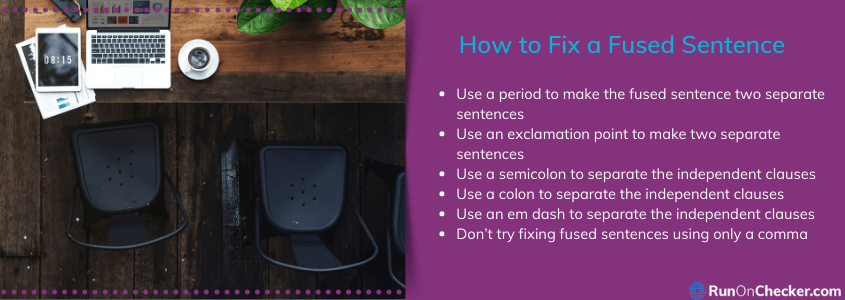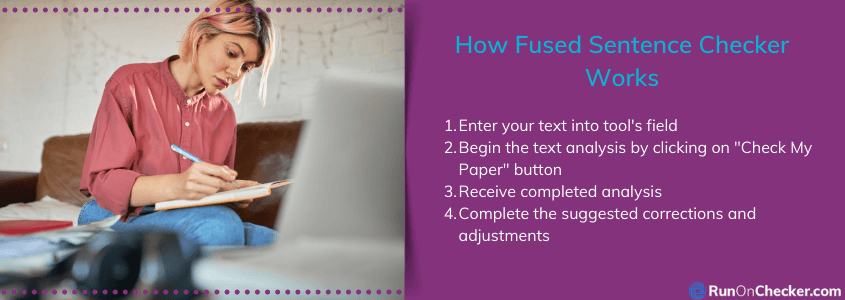Finding Fused Sentences Is Important
Fused sentences are a type of run on error that makes your writing harder to read and more difficult to understand. Therefore, it is important to know how to fix a fused sentence if you want your writing to communicate your message effectively. The fact that this type of run on sentence occurs often makes it even more critical that you learn to identify the fused sentence mistakes in your text and fix them.
Before you can learn how to spot a fused sentence you need to understand what an independent clause is. An independent clause is a group of words that contains a subject, a verb and expresses a complete thought. A fused sentence happens when two or more independent clauses are combined into one sentence without using any punctuation or without a coordinating conjunction. Detecting fused sentences isn’t always easy on your own, but using a tool such as a fragment and run on sentence checker will make it much easier.
How to Fix a Fused Sentence: 10 Secrets to Know
There is more than one way how to revise a fused sentence. Here are 10 tips/secrets for fixing this type of run on sentence including some fused sentence examples and corrections to fix them:

- Use a period to make the fused sentence two separate sentences. Example: “My dog likes to play he will chase a ball for hours.” Correction: “My dog likes to play. He will chase a ball for hours.” A period was placed between the independent clauses and the first word of the second independent clause was capitalized.
- Use an exclamation point to make two separate sentences. Example: “It is too hot I will go inside.” Correction: “It is too hot! I will go inside.” This is not a common way to correct a fused sentence but can be used if you want to emphasize the first independent clause.
- Use a semicolon to separate the independent clauses. Example: “Mary is an excellent student she gets A’s in all her classes.” Correction: “Mary is an excellent student; she gets A’s in all her classes.” Capitalizing the word following the semi-colon isn’t necessary unless it is a proper noun.
- Use a colon to separate the independent clauses. Example: “The yard was huge it took 5 hours to cut the grass.” Correction: “The yard was huge: it took 5 hours to cut the grass.” It isn’t necessary to capitalize the word following the colon unless it is a proper noun.
- Use an em dash to separate the independent clauses. Example: “John really enjoys the outdoors he goes hiking every vacation.” Correction: “John really enjoys the outdoors – he goes hiking every vacation.” Capitalizing the word following the dash isn’t necessary.
- Use a comma and a coordinating conjunction to separate the independent clauses. Example: “John enjoys watching television his brother prefers reading books.” Correction: “John enjoys watching television, but his brother prefers reading books.” The independent clauses were separated by a comma followed by the coordinating conjunction “but”.
- Use subordinating conjunction to separate the two independent clauses making the second independent clause a dependent clause. Example: “George was unable to drive to work his car broke down.” Correction: “George was unable to drive to work because his car broke down.” The subordinating conjunction “because” was used to separate the independent clauses.
- Use subordinating conjunction at the beginning of the fused sentence to turn the first independent clause into a dependent clause. Example: “Alice missed the bus this morning she was late for work.” Correction: “Since Alice missed the bus this morning she was late for work.” The subordinating conjunction “since” was added to the beginning of the fused sentence.
- Use a conjunctive adverb with a comma and semicolon to separate independent clauses. Example: “The restaurant was fully booked we ate at home.” Correction: “The restaurant was fully booked; instead, we ate at home.” The semi-colon comes first, followed by the conjunctive adverb then the comma.
- Don’t try fixing fused sentences using only a comma. That will just turn the fused sentence into a comma splice which is also a type of run on sentence and a grammatical error. You don’t want to just exchange one type of error for another.
If you are still unsure how to revise a fused sentence you may want to consider using our fused/run on sentence and comma splice checker to assist you with the proofreading and editing process.
Benefits of Using a Fused Sentence Finder
Tools like our fused sentence finder have become popular with students and writers when it’s time to proofread and edit papers and other text. Not only do they identify comma splices and fused sentences, but they also make suggestions on how to correct run on sentences they have identified. In addition, our comma splices and fused sentences checker detects other types of grammar errors such as sentence fragments and punctuation mistakes among others. It also functions as a spelling checker and examines your word usage and the tone of your text. Our sentence checker works on any type of text including academic papers, essays, memos, blog posts or any other type of writing. It is fast and generally takes less than a minute to analyze text, identify mistakes and suggest corrections. To top things off it is easy to use. Just follow these steps:

- Copy and paste your text into the field provided
- Click the button to start the text analysis
- Receive a report identifying fused sentences and other errors in your text along with suggestions on how to correct the mistakes
- Make the suggested corrections




